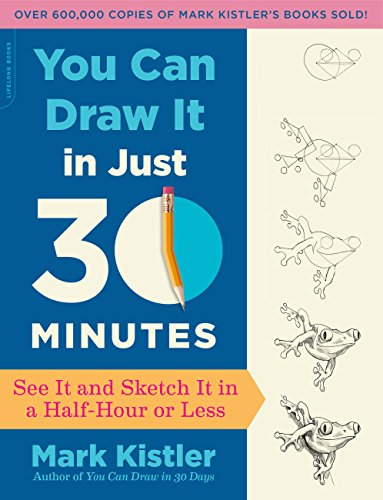I am a long-time fan of Mark Kistler’s drawing courses. You can read my review of Mark Kistler’s Draw Squad by clicking here. Young children probably would do best starting with Draw Squad, but those about fifth grade and beyond, including adults should do well with Kistler's book You Can Draw It in Just 30 Minutes.
You Can Draw It in Just 30 Minutes has 25 lessons with a bonus challenge for each lesson—a total of 50 drawing activities. In addition, students can try some of the lessons again, maybe adding their own variations to them as they improve their skills.
Kistler makes it easy for the novice sketcher. He shows students how to identify basic shapes within an object such as circles, squares, triangles or curved lines. He shows step-by-step how to sketch the basic shapes then he shows how to finesse those shapes into realistic images, including shading, contouring, and other details. Paper and pencil are all that are required.
He introduces each lesson with a photo of the object and shows the basic shapes that are involved. He often introduces what he calls “hacks” that help students with the sizes and shapes. For example, for drawing a seahorse he has students trace a quarter to form the body and a dime to form the head. These are just simple tricks to make the process easier. Kistler explains hacks, tips, and techniques for the drawing before students begin. Reading through these is a must! After this, the actual instructions that students will follow as they draw are arranged in order on one page, and it faces a mostly blank drawing page where students can draw directly in the book if they wish. The “blank” page has two small illustrations showing how the basic shapes are placed for immediate reference. The book doesn’t lie flat, so I’m not sure that drawing in the book will work that well. Personally, I’d probably have students use a small drawing tablet—similar in size to the blank page space so that their drawing stays contained in a relatively small space.
Drawings gradually get more complex as Kistler teaches different techniques and introduces the vocabulary of art along the way. There’s a glossary of art terms used at the back of the book .
The first lesson is drawing a partially pealed banana. Examples of other objects to be drawn are a chair, a penguin, a basket of tomatoes, a pencil, a hand with a pointing finger, a tree frog, a blender, and ballet slippers. Bonus drawings often utilize elements of the main lesson, but expand upon it or take it another direction. For example the bonus for the penguin lesson has students draw a slightly different penguin, placing him on an ice floe, and mirroring his image as a reflection. The bonus lesson for the seahorse lesson has students draw a leafy sea dragon using entirely different shapes than in the main lesson.
Many lessons teach basic drawing skills through drawing actual objects. For example, drawing a wedding cake teaches how to draw ovals, how to do blended shading on cylindrical shapes, and visual distortion to show that the center edges of the cake are closer than the sides. While some lessons might look simple enough for younger children, the accumulation of skills and the increasing levels of difficulty make it more suitable for older students.
As with Draw Squad, You Can Draw It in Just 30 Minutes is a great starting place for developing drawing skills. Kistler makes it so easy to follow the lessons and be successful.










